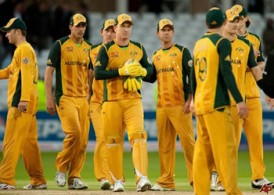Australia and Twenty20 cricket
Marco Trevisiol |
The impact of Twenty20 cricket has been remarkable not just for how much it has changed the game but for how quickly it has occurred; despite its immediate popularity until the inaugural World Cup in late 2007 it was seen by large segments of the cricket community as a non-serious form of cricket. Its success, popularity and relevance has taken much of the cricket community by surprise and there is no better example of that than in Australia. Usually at the forefront of trends and innovation, the brief history of Twenty20 cricket in Australia shows key players and authorities being dismissive and fearful of its significance and impact.
Twenty20 first made its presence felt in Australia during the 2004/05 season when the touring Pakistan side played Australia A at a packed Adelaide Oval. The following season Australia played its first home international Twenty20 match and a domestic state-based competition was started which looks like a mouse now compared to the structure this season; it comprised just 7 matches with no TV coverage and it being perceived as little more than an exhibition tournament that hopefully would generate local interest at state level.
Another demonstration that cricket authorities saw Twenty20 as a mere gimmick occurred in 2006/07 when New South Wales signed up rugby league great Andrew Johns to be part of their side. In response to criticism of this move, NSW Cricket’s CEO Dave Gilbert responded by saying “Nobody loses sleep if they win or lose.”(1)
This attitude towards Twenty20 was reflected when an inaugural World Cup was announced in 2007. In normal circumstances, a cricket World Cup would have all sections of Australian cricket displaying the highest levels of preparation and intensity. Instead, leading up to it Australian players were quite open in their dubiousness about the concept. Andrew Symonds was quoted as saying:
“The thing people love about Twenty20 is that it’s fun and fresh, but it’s also not played that often. It’s a good thing as long as it’s not taken that seriously. Now there’s a World Cup it’s obviously going to be taken seriously. That might be a bit of a shame.” (2)
This perspective that Twenty20 wasn’t proper cricket were reflected by Nathan Bracken who observed that “If you take it too seriously it will just do your head in,” (3)
It was little wonder with this mindset that Australia – in contrast to their ruthless dominance of the one-day World Cup earlier that year – suffered the humiliation of defeat to Zimbabwe in their opening match. While they recovered from his awful start, they suffered two more defeats and were knocked out in the semis; by Australian standards it was a disappointing performance.
Up to this point Australian cricket’s ambivalence towards Twenty20 could be understood as it was shared by large segments of the cricketing community. But the enormous success of the World Cup (especially in contrast to the dismal one-day version earlier that year) meant that whatever one thought of it, Twenty20 was here to stay.
And yet in multiple ways Australian cricket’s attitude continued to be a mixture of ambivalence and dismissal as evidenced in how they selected the squad for the 2009 World Cup.
By now the domestic Twenty20 competition had expanded significantly and highlighted many quality players in this format. But with the exception of Dave Warner, they were largely ignored as the selectors took the lazy option of the side being a virtual copy of the one-day lineup when it had become apparent that they were formats requiring different types of players and tactics. The most notorious player overlooked was Brad Hodge but even more baffling was the treatment of Dirk Nannes who had bowled superbly for Victoria in the 2008/09 tournament yet couldn’t even get into the 30 man provisional squad.
The preparation was further weakened when central members of Australia’s Twenty20 squad were regularly rested from matches leading up to the event, meaning that they were seriously underprepared for the tournament (especially when you factor in they didn’t get the chance to play in the domestic Twenty20 competition).
In light of all this, it was no surprise that Australia bombed out of the tournament at the first stage without a win while the likes of Ireland progressed further. It also meant their losing streak in Twenty20’s away from home was now 8.
A change in attitude was required in Australia’s treatment and selection of its Twenty20 sides and while there were signs of that in more suitable players picked for the abandoned England series last year, the selection of Michael Clarke as the new Twenty20 captain suggests there’s a way to go. His record at international level is dire; in 19 matches he has an average under 20 and has a strike barely above 100, far too slow for this format of the game.
This is mainly because his style of batting is somewhat old-fashioned in that relies more on timing, placement and hitting along the ground as opposed to brute force and aggression and hitting in the air that characterises so many players presently. That’s worked well in Tests and one-dayers but is ill-suited to this format. In normal circumstances he wouldn’t be near the side but because he’s next in line to be Test/one-day captain, he’s effectively been given this role as a form of ‘work experience’ which suggests that Australian cricket is still treating Twenty20 as a semi-serious venture. In terms of skills and experience vice-captain Cameron White would have been a much more suitable choice as the new captain.
This season Twenty20 has gone from strength to strength, with attendances and TV ratings for the domestic one-day competition smashing previous records. However the response from sections of Australian cricket and players like Ricky Ponting was not to welcome this new level of popularity but to react with trepidation and fear and the negative impact it could have on other forms of the game. While one can understand strong defences of Test cricket and the Sheffield Shield, why one-day cricket? Before Twenty20 came along there was already increasing evidence that fans had grown tired of the format; whereas in the 1980s and 1990s it was fresh and exciting, in the 2000s it was increasingly perceived as dull and mechanical and showcasing the worst aspects of the game.
Comments like those from Ponting recently that he saw no sign of decline in interest in one-day cricket don’t stand up to analysis. Even before Twenty20 came along in Australia, there was clear evidence that one-day cricket crowds were in decline, especially at the Melbourne Cricket Ground. After regularly providing packed houses there in the 1980s and 1990s, crowds have steadily dropped off in recent years to the extent that the crowds for both of last year’s one-day internationals drew clearly less than the 43,000 that turned up to the Victoria/Tasmania Twenty20 match a couple of weeks back.
In the current environment, it is no surprise that one-day cricket is in such trouble. After all, it would be hard to envisage a significant section of cricket fans who prefer it to Twenty20 or Tests. What does it have to offer that other formats do not? The attempts to tinker and add new features to it only underline its problems and lack of appeal.
As it has shown through its success at Australian domestic level, Twenty20 has plenty to offer Australian cricket, but it needs a more accommodating and open-minded attitude from those in influence and power before its capabilities can be fully utilised.
———————————————————-
1 – ‘Johns ‘farce’ stirs up a storm’ Foxsports, By Iain Payten and James Phelps, January 09 2007, (http://www.foxsports.com.au/story/0,8659,21029915-23212,00.html)
2 – ‘Twenty20 title-fight worries Symonds Cricinfo’, By Cricinfo Staff, July 19 2007, (http://www.cricinfo.com/australia/content/story/302600.html)
3 – ‘Twenty20 can do your head in’ Cricinfo, By Cricinfo Staff, July 13 2007, (http://www.cricinfo.com/australia/content/story/301780.html)





You should be a journalist, that was a terrific article. I do agree that the 20/20 format is much more exciting than the one day and also provides an opportunity to try out fresh talent and provide new challenges for the cricketers as we are now in the 21st century. It also toughens up the competition to make it much more exciting and not so one-sided too.
Comment by No 1 Cricket Fan. | 12:00am GMT 6 February 2010